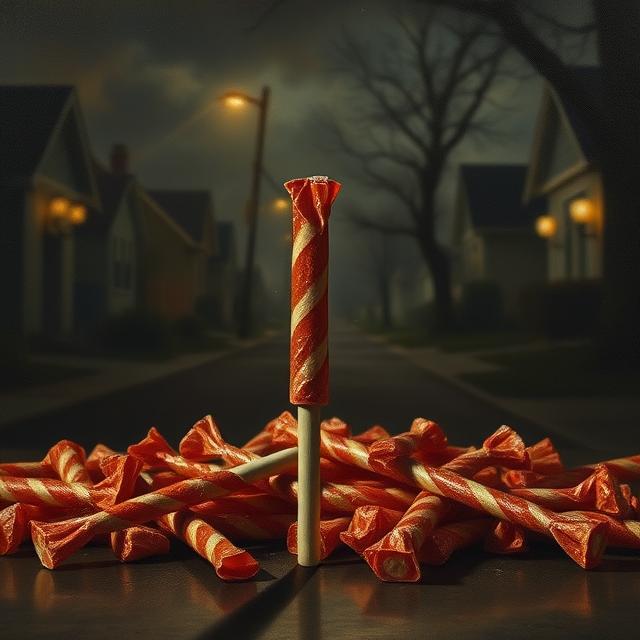Halloween night, October 31, 1974, was meant to be a night of innocent fun and sugary delights for children across the United States. But in Deer Park, Texas, a suburb of Houston, the evening took a dark and deadly turn, forever shattering the carefree image of trick-or-treating. Ronald Clark O’Bryan, a 30-year-old optician and father of two, accompanied his eight-year-old daughter, Elizabeth, and five-year-old son, Timothy, along with their neighbor’s children, on their Halloween rounds. What unfolded that night was not a random tragedy but a calculated act of malice that would earn O’Bryan a place in the annals of true crime as the “Candyman Killer.”
As the group of children went door-to-door collecting treats, O’Bryan lagged behind at one house that didn’t answer. He rejoined the group moments later, producing five large Pixy Stix candies, claiming they were a special treat from that house. He gave one to each of the children, including his own, and one to a neighbor boy, Jim Bates. Later that evening, Timothy O’Bryan became violently ill after consuming his Pixy Stix. He died a short time later at the hospital.
The immediate assumption was that the candy had been tampered with, sparking widespread fear of poisoned Halloween treats. Local authorities and even the FBI launched an investigation, urging parents to carefully inspect their children’s candy. The image of razor blades in apples and poisoned candy became a national nightmare, forever changing the way Halloween was perceived.
However, as the investigation progressed, suspicion began to fall on Ronald O’Bryan himself. His seemingly distraught demeanor and cooperative attitude with the police began to unravel under scrutiny. Investigators learned that O’Bryan was deeply in debt and had recently taken out a significant life insurance policy on his children, just weeks before Halloween. The policy on Timothy was for $10,000, and O’Bryan had inquired about increasing it shortly before the boy’s death.
Further inconsistencies in O’Bryan’s account of that Halloween night began to emerge. His claim about the house that gave out the special Pixy Stix proved false. He couldn’t accurately describe the resident, and no one in the neighborhood recalled such a large Pixy Stix being handed out. The other children who received the Pixy Stix from O’Bryan were unharmed, as they had either not eaten them or had only taken a few bites. Jim Bates, the neighbor boy, had been given a Pixy Stix by O’Bryan but had not opened it.
The pieces of the puzzle began to fit together, painting a chilling portrait of a father who had seemingly orchestrated the poisoning of his own son for financial gain. The Pixy Stix that killed Timothy was found to contain a lethal dose of cyanide. The other Pixy Stix O’Bryan had distributed were also tested, and while some contained no poison, others had been tampered with. Investigators concluded that O’Bryan had likely intended to poison all five of the children who received the candy, hoping to collect on the life insurance policies.
The motive appeared to be purely financial. O’Bryan was facing significant financial difficulties, including job loss and mounting debts. The life insurance policies on his children offered a twisted and desperate solution to his problems. The fact that he included other children in his plan suggested a callous disregard for innocent lives and a willingness to gamble with their safety to mask his intended target.
Ronald O’Bryan was arrested on November 5, 1974, just days after Timothy’s death. The trial that followed captivated the nation, as the seemingly unthinkable crime of a father murdering his own child for money unfolded in the courtroom. The prosecution presented a compelling case, highlighting O’Bryan’s financial troubles, the life insurance policies, and the inconsistencies in his alibi. The false story about the Pixy Stix house was a key piece of evidence, demonstrating O’Bryan’s attempt to deflect blame.
The defense argued that O’Bryan was being unfairly targeted and that the real killer was still at large. However, the overwhelming evidence against him, including the fact that he was the one who distributed the poisoned candy and his clear financial motive, swayed the jury. On June 3, 1975, Ronald Clark O’Bryan was found guilty of capital murder and four counts of attempted murder. He was sentenced to death.
O’Bryan spent the next decade and a half on death row, maintaining his innocence until the very end. Numerous appeals were filed and denied. On March 31, 1984, Ronald Clark O’Bryan was executed by lethal injection. His last words were a defiant declaration of his innocence and a curse upon those who had convicted him.
The crime committed by Ronald O’Bryan had a profound and lasting impact on American culture, particularly concerning Halloween. The fear of poisoned candy became deeply ingrained in the national psyche. While statistically, instances of widespread candy tampering by strangers on Halloween are exceedingly rare, the O’Bryan case served as a stark and terrifying example of the potential for hidden danger.
In the years following Timothy O’Bryan’s death, Halloween traditions changed significantly. Many parents became far more cautious about allowing their children to trick-or-treat unsupervised. Organized Halloween events, such as mall trick-or-treating and community parties, gained popularity as safer alternatives to going door-to-door in neighborhoods. The ritual of carefully inspecting every piece of candy became a common practice in many households.
The story of the “Candyman Killer” serves as a chilling reminder that evil can sometimes reside in the most unexpected places, even within a parent’s love. Ronald O’Bryan’s greed and desperation led to the tragic death of his own son and forever cast a shadow over a holiday that was once synonymous with innocent joy. The echoes of that Halloween night in 1974 continue to resonate, a cautionary tale etched into the American consciousness, forever changing the way we view the simple act of a child collecting candy.
Want to explore the shadows even deeper? For more chilling cases like this, visit SinisterArchive.com, where the legends are real.




